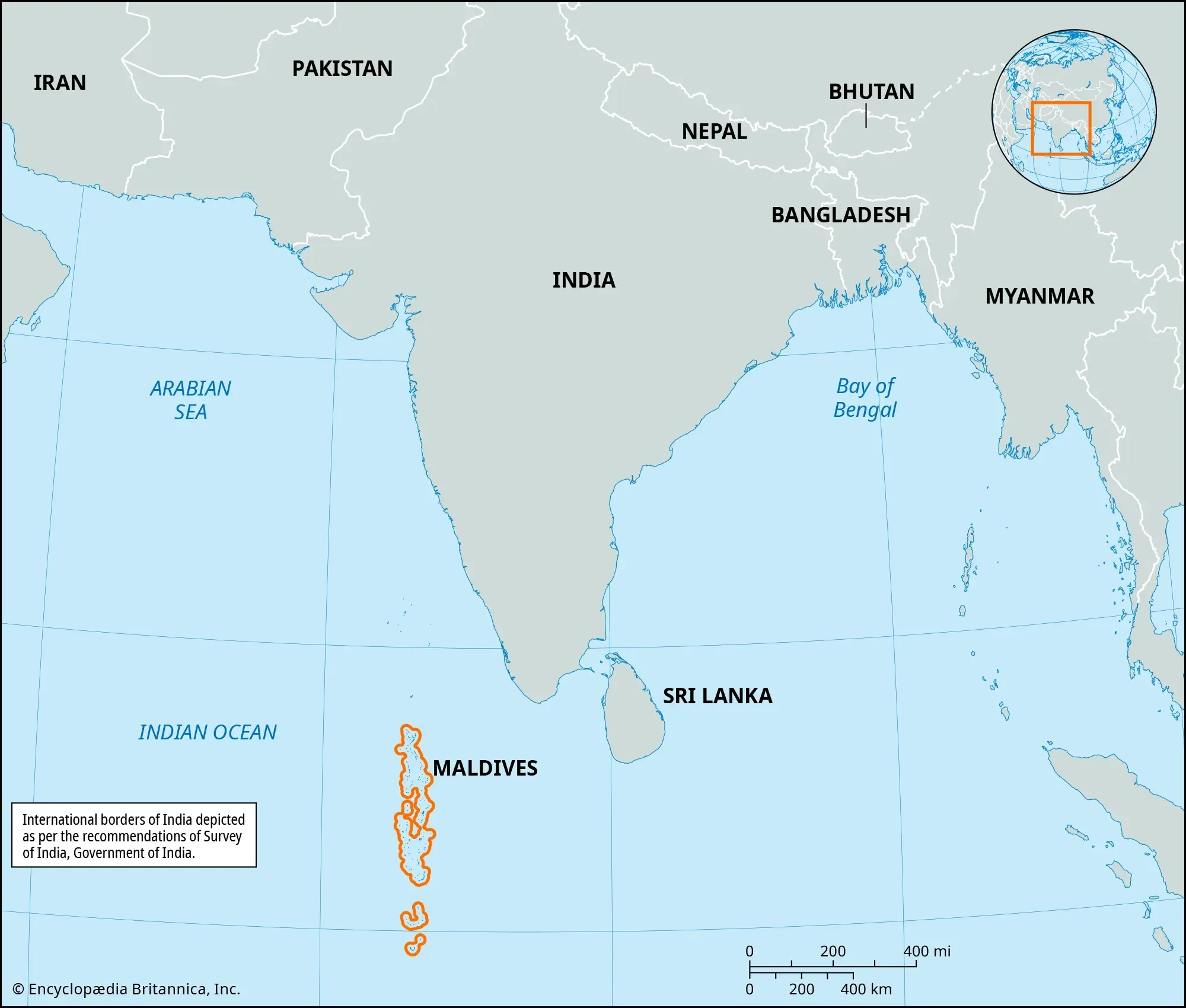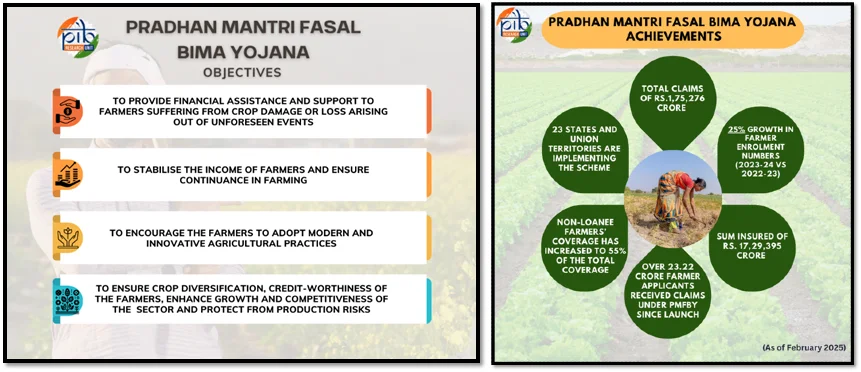International Relations
Reset in India-Maldives Relations
For Prelims: MAHASAGAR, Free Trade Agreement (FTA), Bilateral Investment Treaty (BIT), Aarogya Maitri Health Cubes (BHISHM), Operation Neer, Operation Cactus, EEZ, Colombo Security Conclave.
For Mains: Significance of a healthy India-Maldives relations for maintaining peace, stability and prosperity in the Indian Ocean region.
Why in News?
India's Prime Minister participated as the guest of honour at the 60th Independence Day celebrations of the Maldives, marking a reset in bilateral ties between the two nations.
- This is significant as India-Maldives ties have been strained under the current Maldivian President due to his India Out campaign and derogatory social media remarks by officials linked to his administration.
What are the Key Outcomes of the Visit?
- Progress on Strategic Partnership: Both countries reviewed the progress of the 2024 Economic and Maritime Security Partnership, and India reaffirmed its "Neighbourhood First" and MAHASAGAR policies.
- Economic & Digital Partnership: India highlighted that the proposed Free Trade Agreement (FTA) and Bilateral Investment Treaty (BIT) would create new opportunities for both nations.
- Both countries welcomed agreements on UPI, RuPay card, and local currency trade to boost the digital economy and tourism.
- Financial Support: India extended a USD 550 million Line of Credit (LoC) for infrastructure, while an Amendatory Agreement on existing LoCs cut Maldives’ annual debt repayment by 40%.
- Infrastructure & Social Projects: Both countries inaugurated key infrastructure projects, including roads and drainage in Addu City, 6 community development projects, and 3,300 social housing units.
- Healthcare & Disaster Support: India donated two Aarogya Maitri Health Cubes (BHISHM), equipped to provide emergency medical aid for up to 200 casualties.
What Encouraged the Maldives to Recalibrate its Ties with India?
- Severe Economic Crisis: The Maldives was recently grappling with a major economic downturn, with foreign exchange reserves falling to USD 440 million.
- Adding to the strain, Moody’s downgraded the country’s credit rating due to the risk of debt default.
- Economic Dependence on India: The Maldives relies heavily on Indian tourists, a key source for its tourism sector. Strained ties led to a loss of around USD 150 million.
- India also supplies essential goods like food, medicines, and construction materials to Maldives.
- India’s Strategic Role: India has historically played a vital role in Maldives' development and security. Alienating India could jeopardize regional stability and security.
- The Maldivian President acknowledged India as the ‘First Responder’ during crises like the 2014 water crisis (Operation Neer), Covid-19 pandemic, and Operation Cactus (1988), highlighting strong security and humanitarian ties.
- Geopolitical Balancing with China: The softened stance reflects a pragmatic effort to balance relations with both India and China, ensuring the Maldives can benefit from India’s support while maintaining a diversified foreign policy.
- Political Realism: It signals a strategic recalibration to protect and strengthen ties with India, recognizing its economic and geopolitical significance.
Why is a Reset in India-Maldives Relations Crucial for Both Nations?
Significance of Maldives for India
- Strategic Location: Positioned along key International Shipping Lanes (ISLs) in the Indian Ocean, the Maldives plays a crucial role in facilitating global trade and energy flow.
- Notably, 50% of India’s external trade and 80% of its energy imports transit through these waters.
- Countering China’s Influence: India considers the Maldives a strategic ally to help counterbalance China’s growing presence in the Indian Ocean region and safeguard its own security interests.
- Indian Ocean as India’s Strategic Sphere: India views the Indian Ocean as its backyard, making a stable and cooperative maritime environment vital to its strategic goals. The Maldives is a key partner in ensuring regional maritime stability.
India’s Significance for Maldives
- Security Cooperation: India has a longstanding role as a security provider, notably through Operation Cactus (1988) to thwart a coup, and regular joint exercises like Ekuverin, Dosti, and Ekatha to enhance defense collaboration.
- Tourism Contribution: Indian tourists have emerged as the top source market for the Maldives accounting for 11.2% of arrivals in 2023.
- Education Partner: India is the preferred destination for Maldivian students pursuing higher education, offering scholarships and access to prestigious institutions.
- Climate Change Cooperation: Given the Maldives’ vulnerability to sea-level rise and other climate-related risks, it serves as a significant partner for India in advancing climate change adaptation and mitigation efforts.
- Disaster Relief and Humanitarian Support: India has consistently extended aid during emergencies, including tsunamis, drinking water shortages, and the Covid-19 pandemic, reinforcing its role as a dependable partner.
What can be Done to Further Strengthen India-Maldives Relations?
- Economic & Developmental Cooperation: India and Maldives should expedite the FTA, boost Indian investments, and adopt local currency trade to enhance economic ties.
- India should fast-track key projects like Greater Malé Connectivity Project (GMCP), and develop undersea cable links to strengthen digital infrastructure and reduce Chinese dependence.
- Security & Strategic Collaboration: India should strengthen maritime security with the Maldives through joint patrols, EEZ monitoring, donation of patrol vessels and drones, and enhanced intelligence-sharing.
- India should leverage the Colombo Security Conclave to enhance regional security cooperation.
- People-to-People Ties: India should counter the India Out narrative by engaging Maldivian youth and supporting independent media, while encouraging film collaborations to boost cultural ties.
- Diplomatic & Political Outreach: India should pursue high-level engagement through frequent visits and Track-II diplomacy (think tanks, academic exchanges), while avoiding public spats, and addressing sovereignty concerns with sensitivity.
Conclusion
The India-Maldives reset is crucial for regional stability, countering China’s influence, and mutual economic growth. By prioritizing trade, security, and people-to-people ties, India can solidify its role as Maldives’ trusted partner. Strategic diplomacy, timely project execution, and soft power engagement will ensure long-term cooperation in the Indian Ocean.
|
Drishti Mains Question: Examine the strategic and economic significance of Maldives for India in the context of changing regional geopolitics. |
UPSC Civil Services Examination, Previous Year Questions (PYQs)
Mains
Q. Discuss the geopolitical and geostrategic importance of Maldives for India with a focus on global trade and/energy flows. Further also discuss how this relationship affects India’s maritime security and regional stability amidst international competition? (2024)
Q. Discuss the political developments in the Maldives in the last two years. Should they be of any cause for concern to India? (2013)


Indian Economy
Outlook of Indian Economy
For Prelims: Reserve Bank of India, Consumer Price Index, Inflation, Current Account Deficit, Gross fiscal deficit , Foreign Portfolio Investment
For Mains: State of the Indian economy and macroeconomic indicators, Inflation and fiscal discipline, State finances
Why in News?
The Reserve Bank of India's article titled “State of the Economy” offers a cautiously optimistic view of the Indian economy, amid global and trade-related uncertainties.
What is India's Present State of the Economy?
- Inflation: Retail inflation (measured by the Consumer Price Index (CPI) fell from 5.4% in 2023–24 to 2.1% in June 2025, the lowest since January 2019.
- In June 2025, core inflationrose to 4.4% due to costlier personal care, education, and recreation, while overall inflation eased more sharply in rural (1.7%) than urban areas (2.6%).
- Balance of Payments: India recorded a current account surplus of 1.3% of Gross Domestic Product (GDP) in Q4 2024–25.
- India’s Current Account Deficit narrowed to 0.7% of GDP in FY24.
- Fiscal Developments: Gross fiscal deficit (GFD) stood at 0.8% of its 2025-26 budget estimates, a significant improvement from 3.1% in 2024-25
- Till May 2025, the Centre received 21% of Budget Estimates (BE) 2025-26 of Total Receipts. Total expenditure stood at 14.7% of FY26 BE, with a notable focus on capital expenditure.
- Trade Performance: India’s overall trade deficit narrowed nearly 30% in May 2025, mainly due to falling oil prices and strong services exports.
- Compared to May 2024, total exports in May 2025 grew by 2.8% boosted by a 9.4% rise in services exports, while total imports fell by 1%.
- India’s export performance in FY 2024–25 was driven by strong growth in sectors like coffee, tobacco, electronic goods, rice, and drugs & pharmaceuticals.
- Other sectors such as ready-made garments (RMG) of textiles, plastic & linoleum, engineering goods, and fruits & vegetables also saw positive growth.
- The US, UK, Japan, UAE, and France emerged as top export destinations during the year.
- On the import front, major sources included UAE, China, Thailand, US, and Russia.
- Foreign Direct Investment (FDI): FDI inflows up 14% in FY25 from FY24, and 125% higher than FY14.
- The services sector led with 19% of equity inflows, followed by software & hardware (16%) and trading (8%).
- Manufacturing FDI rose by 18% in FY25 compared to FY24, Maharashtra topped with 39% of inflows, while Singapore was the largest source (30%), followed by Mauritius and the US.
- Foreign Portfolio Investment (FPI): India witnessed positive net Foreign Portfolio Investment (FPI) inflows of USD 44.1 billion in FY24.
- External Debt: India's external debt rose by 10% in 2025 compared to 2024, with the debt-to-GDP ratio rose slightly to 19.1% from 18.5% FY24.
- Foreign Exchange Reserves: India's foreign exchange reserves stood at USD 696 billion as of July 2025, covering over 11 months of goods imports and 95% of external debt.
What are the Factors Affecting the Indian Economy at Present?
- Global Headwinds:
- Geopolitical and Trade Tensions: Ongoing Iran-Israel tensions and uncertainty around US tariff policies are keeping the global environment unstable.
- Global tariff rates may rise to levels last seen in the 1930s, which could raise India’s import costs and worsen inflation.
- Weak Global Confidence: Consumer and business sentiment remains subdued worldwide, slowing the pace of global recovery.
- This reduces demand for Indian exports, especially in sectors like manufacturing and IT services.
- Sticky Global Inflation: Inflation has increased in advanced economies and remains elevated in emerging markets like Brazil and Russia.
- This may lead to tighter global monetary policy, which can restrict foreign capital flows into India and increase borrowing costs.
- Geopolitical and Trade Tensions: Ongoing Iran-Israel tensions and uncertainty around US tariff policies are keeping the global environment unstable.
- Domestic Activity:
- Industrial Slowdown: Growth in the Index of Industrial Production (IIP) fell to 1.2% in May 2025, the lowest since August 2024.
- This hampers job creation and weakens momentum in industrial and manufacturing sectors.
- Drop in Credit Growth: Bank credit to Non-Banking Financial Companies (NBFCs) and industry declined.
- NBFC loan disbursals dropped 13% year-on-year in the September 2024 quarter. Urban loan sanctions fell 23%, and long-term loans dropped by 50%.
- Loans against securities and education loans also saw sharp declines. This curbs business investment and slows economic expansion.
- Slower GST Revenue Growth: Goods and Services Tax (GST) collections grew by only about 6% in June 2025, the slowest pace in four years.
- This suggests weakening demand, a cautious business sentiment, and adds pressure on government finances.
- Labour Market Strain: While unemployment remained steady at 5.6% in June 2025, rural labour force participation declined due to the agricultural lean season and extreme heat.
- This signals stress in rural employment, which can hurt rural consumption and overall demand.
- State Finances: States face rising subsidy burdens from loan waivers and free services, which strain finances and divert funds from infrastructure.
- Industrial Slowdown: Growth in the Index of Industrial Production (IIP) fell to 1.2% in May 2025, the lowest since August 2024.
Way Forward
- Fast-track Trade Deals: Expedite FTAs with key partners like the US to cushion against tariff hikes and open new markets.
- Invest in export infrastructure, port efficiency, and quality certification to help Indian goods compete globally.
- Boost Rural Demand and Job Creation: Expand rural employment programs during lean agricultural seasons and heatwaves.
- Shift focus from just transfers to rural skilling and non-farm livelihood support, especially for youth and women. Improve irrigation, cold storage, and market linkages to make farming more resilient.
- Maintain Macro Stability While Supporting Growth: Control inflation through supply-side steps while sticking to the fiscal glide path.
- Keep policies stable and investor-friendly to ensure capital flows. Use forex reserves to support essential imports like energy and tech.
Conclusion
India needs disciplined, steady, and state-led execution. Balancing welfare with investment, and exports with domestic demand, will be key to turning current challenges into a long-term growth opportunity.
UPSC Civil Services Examination, Previous Year Questions (PYQs)
Prelims
Q. In the ‘Index of Eight Core Industries’, which one of the following is given the highest weight? (2015)
(a) Coal production
(b) Electricity generation
(c) Fertilizer production
(d) Steel production
Ans: (b)
Q. Increase in absolute and per capita real GNP do not connote a higher level of economic development, if: (2018)
(a) Industrial output fails to keep pace with agricultural output.
(b) Agricultural output fails to keep pace with industrial output
(c) Poverty and unemployment increase.
(d) Imports grow faster than exports.
Ans: (c)
Q. In a given year in India, official poverty lines are higher in some States than in others because: (2019)
(a) Poverty rates vary from State to State
(b) Price levels vary from State to State
(c) Gross State Product varies from State to State
(d) Quality of public distribution varies from State to State
Ans: (b)
Mains
Q. Do you agree that Indian economy has recently experienced V–shaped recovery? Give reasons in support of their answer. (2021)
Q. Do you agree with the view that steady GDP growth and low inflation have left the Indian economy in good shape? Give reasons in support of your arguments. (2019)
Q. “Industrial growth rate has lagged behind in the overall growth of Gross-Domestic-Product(GDP) in the post-reform period” Give reasons. How far the recent changes in Industrial Policy capable of increasing the industrial growth rate? (2017)


Facts for UPSC Mains
Pradhan Mantri Fasal Bima Yojana
Why in News?
The Pradhan Mantri Fasal Bima Yojana (PMFBY) has seen major expansion, but states have defaulted on approx. Rs 6,450 crore in claim settlements since FY20, raising concerns over delays and farmer support.
What is the Pradhan Mantri Fasal Bima Yojana (PMFBY)?
- About: The PMFBY is a government-sponsored crop insurance scheme launched by the Ministry of Agriculture & Farmers Welfare.
- It aims to provide financial support to farmers in the event of crop loss due to natural calamities, pests, or diseases and to stabilize their income.
- Premium: Farmers pay a capped premium of 2% (Kharif), 1.5% (Rabi), and 5% (commercial/horticultural crops).
- The remaining premium is shared between the Centre and States in a 50:50 ratio, and 90:10 for North-Eastern States from Kharif 2020.
- Premium rates depend on crop risk, insured area, and notified crops.
- Key Benefits of PMFBY:
- Broad Coverage: Covers crop loss from natural disasters, pests, diseases, and post-harvest localised events.
- Faster Compensation: Aims to settle claims within two months post-harvest.
- Tech-Based Assessment: Uses satellite, drones, and mobile tech for accurate loss estimation and quick claim settlement.
- Farmer Coverage: The scheme is voluntary and open to all States, Union Territories (UTs), and farmers. For every Rs 100 of premium paid by the farmers, they have received nearly Rs 500 as claims.
- Since 2016, over Rs 1.78 lakh crore has been paid out in claims, which is 5 times the total premium paid by farmers.
- Awareness campaigns like Fasal Bima Saptah and Meri Policy Mere Haath, along with village-level events like Fasal Bima Pathshalas, helped boost participation and close the information gap.
What are the Challenges Affecting the Implementation of PMFBY?
- Large-Scale State Defaults: States like Andhra Pradesh, Rajasthan, and Madhya Pradesh have delayed their premium contributions.
- This has impacted the timely settlement of farmer claims and eroded trust in the scheme.
- Delayed Payouts: Farmers have often faced delays in receiving claims, undermining the scheme’s core objective of timely risk mitigation.
- Assessment Bottlenecks: Manual and outdated crop loss assessment methods have often led to discrepancies and inefficiencies.
- Limited Private Sector Confidence: Repeated payment delays and high claim ratios have deterred some insurance companies from active participation.
- Disparity in Enrollment: Although 4.19 crore farmers were enrolled in 2024–25, categories like tenant (6.5%) and marginal (17.6%) farmers remain underrepresented compared to loanee farmers (48%).
What Measures have been Introduced to Improve PMFBY?
- Digital Reforms: National Crop Insurance Portal (NCIP) developed as a single platform for farmer enrolment, claim tracking, and direct benefit transfer.
- Digiclaim Module operational since Kharif 2022, integrates NCIP with PFMS and insurers’ systems to ensure timely, transparent claim processing.
- A 12% penalty is auto-imposed on insurers for claim delays from Kharif 2024 onwards.
- Crop Cutting Experiments (CCEs)-Agri App captures crop cutting experiment data, directly uploaded to the NCIP.
- YES-TECH (Yield Estimation System Based on Technology), which uses remote sensing to estimate crop yields more accurately.
- From Kharif 2023, YES-TECH became mandatory for paddy and wheat. Soybean was added in Kharif 2024.
- WINDS (Weather Information Network and Data System) expanded the network of weather stations and rain gauges at Gram Panchayat and block level to support yield estimation, drought management, and better insurance products.
- Digiclaim Module operational since Kharif 2022, integrates NCIP with PFMS and insurers’ systems to ensure timely, transparent claim processing.
- Escrow-Based Advance Premium System: From Kharif 2025–26, states must deposit their share of premiums in escrow accounts to ensure timely fund availability.
- Proportional Claim Disbursal: The Centre’s premium subsidy is delinked from state contributions, farmers will now receive at least the Centre’s share of claim irrespective of state default.
|
Drishti Mains Question: Pradhan Mantri Fasal Bima Yojana has improved financial resilience among vulnerable farmers? Discuss. |
UPSC Civil Services Examination Previous Year Question (PYQ)
Prelims
Q. With reference to ‘Pradhan Mantri Fasal Bima Yojana’, consider the following statements: (2016)
- Under this scheme, farmers will have to pay a uniform premium of two percent for any crop they cultivate in any season of the year.
- This scheme covers post-harvest losses arising out of cyclones and unseasonal rains.
Which of the statements given above is/are correct?
(a) 1 only
(b) 2 only
(c) Both 1 and 2
(d) Neither 1 nor 2
Ans: (b)
Mains
Q. Given the vulnerability of Indian agriculture to vagaries of nature, discuss the need for crop insurance and bring out the salient features of the Pradhan Mantri Fasal Bima Yojana (PMFBY). (2016)


Important Facts For Prelims
National Crisis Management Committee
Why in News?
The government of India has given statutory backing to the National Crisis Management Committee (NCMC) under the amended Disaster Management Act, 2025, making it the apex decision-making body for national disaster response coordination.
What are the Key Facts About the National Crisis Management Committee (NCMC)?
- Constitution: Formally constituted by the Ministry of Home Affairs under Section 8A(2) of the Disaster Management Act, 2005. Earlier, it existed without formal statutory backing.
- Composition: The NCMC is headed by the Cabinet Secretary. Its members include the Union home secretary, defence secretary, secretary (co-ordination), Cabinet Secretariat and member and head of department, the National Disaster Management Authority (NDMA).
- The chairperson of the NCMC can co-opt experts or officers from central/state governments or any organisation, based on the nature of the crisis.
- Key Functions: The NCMC assesses the country’s disaster preparedness and issues directions to strengthen it.
- It coordinates and monitors the response efforts of central and state governments, NDMA, and other agencies, ensuring smooth and unified disaster management across the country.
Disaster Management Act, 2025
- The Disaster Management (Amendment) Act, 2025 aims to bring clarity and convergence among the various disaster management authorities and committees at national and state levels.
- The Act gives statutory status to key pre-existing bodies like the NCMC and the High Level Committee.
- It empowers NDMA and SDMAs to directly prepare national and state disaster plans, earlier handled by the National Executive Committee (NEC) and State Executive Committees (SECs).
- The Act provides for setting up Urban Disaster Management Authorities (UDMAs) in state capitals and large municipal cities and enables states to constitute their own State Disaster Response Forces (SDRFs), addressing rising urban disaster vulnerabilities.


Rapid Fire
Exercise Bold Kurukshetra 2025
The 14th edition of Exercise Bold Kurukshetra 2025, a joint military exercise between India and Singapore, commenced on 28thJuly in Jodhpur.
- Objective: It aims to validate operational procedures, enhance interoperability, and improve joint training capabilities of both armies in UN peacekeeping scenarios.
- Joint Participants: It involves India’s Mechanised Infantry Regiment and Singapore’s 42 Armoured Regiment of the 4 Singapore Armoured Brigade.
- First initiated in 2005, the annual Bold Kurukshetra exercise reflects deep-rooted military ties between India and Singapore.
- UN Chapter VII authorizes military/non-military actions (sanctions, blockades, troop deployment) for international peace enforcement.
| Read More: India-Singapore Ties |


Rapid Fire
India Cuts Zero-dose Children by 43%
India has reduced the number of zero-dose children from 1.6 million in 2023 to 0.9 million in 2024, playing a key role in South Asia’s highest-ever immunization coverage, as reported by World Health Organization (WHO) and United Nations International Children's Emergency Fund (UNICEF).
- Zero-dose children are those who haven't received even the first dose of the DTP (diphtheria, tetanus, pertussis) vaccine, meaning they are never reached by routine immunization services.
- In 2024, 92% of South Asian infants received the third DTP dose highest ever, up 2% from 2023. Still, over 2.9 million children remain un- or under-vaccinated.
- India's Immunization Drive: India received the Measles and Rubella Champion Award in 2024 for its immunization leadership.
- The Zero Dose Implementation Plan 2024 aims to vaccinate unvaccinated children. The share of zero-dose children in India dropped from 0.11% in 2023 to 0.06% in 2024.
- Mission Indradhanush (Since 2014) has vaccinated 5.46 crore children and 1.32 crore pregnant women previously unreached or under-vaccinated.
- Through National Vaccination Day (16th March), India has maintained polio-free status since 2014.
| Read more: World Immunisation Day 2024 |


Rapid Fire
Financial Conditions Index
The Reserve Bank of India (RBI) has proposed a daily-frequency Financial Conditions Index (FCI) to assess India’s financial market health in real-time to aid policymakers and analysts.
- Objective: The FCI will serve as a composite indicator to measure tight or easy financial conditions relative to historical average since 2012.
- Components: The FCI tracks 20 financial market indicators across money markets, government securities (G-Secs), corporate bonds, equities, and forex markets.
- Positive values of the standardised FCI indicate tighter conditions, while negative values suggest easier financial conditions.
- Trends: During the RBI's sample period, the tightest financial conditions were recorded in July 2013 (taper tantrum, FCI at 2.826) driven by bond and forex market stress, while the easiest conditions occurred in June 2021 (post-Covid, FCI at -2.197) due to the RBI’s liquidity measures.
- A taper tantrum refers to a sudden spike in interest rates, triggered by investors' concerns that a central bank may begin scaling back its bond-buying program (quantitative easing).
- Significance: This initiative highlights India’s commitment to indigenous macro-financial research and real-time policy planning.
| Read More: Role of the Financial Sector in India's Development |








